Trekking to Everest Base Camp: the Ultimate Experience?
The Everest region is by far the biggest trekking draw in Nepal and the classic route to Everest Base Camp is always going to be top of the agenda for many trekkers visiting the country. In the high season (and during better times tourism-wise) this is a very busy trek with teahouse and camping space at a premium.
There is a great temptation among trekkers to get to base camp as soon as possible. However, it is essential not to underestimate the risk of Acute Mountain Sickness (AMS) on this trek. Unless you have walked into the region via the Jiri to Lukla trek (a tough and joyless walk with just one redeeming feature – it’s excellent for acclimatisation and building fitness), you will have arrived into Lukla by flight and will be beginning your walk at 2860m above sea level. This is not an ideal start for any trek, especially one that goes as high as 5545m. Take your time and heed the golden rule of not ascending more than 500m from start to finish in one day when above an altitude of 3000m. By doing this, you not only minimise the risk of AMS, you will also have the opportunity to undertake plenty of fantastic acclimatisation day side trips which will enhance your trek no end.
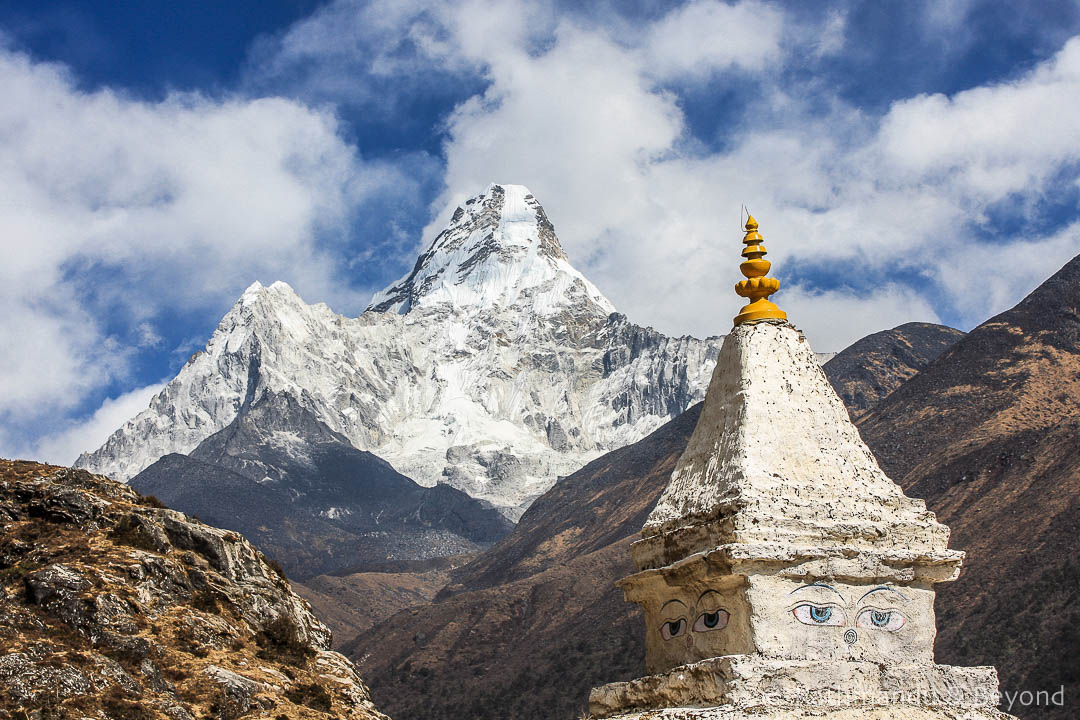 En route between Tengboche and Pyangboche
En route between Tengboche and Pyangboche
And one final point before I delve into the detail of the trek – take more cash (Nepalese rupees) than you think you are going to need. The trek to Everest Base Camp is an expensive one when compared to other treks in Nepal. Everything, from the cost of a room to the price of a litre of boiled/filtered water, is more expensive on this trek and the higher you go, the more you will need to pay. There are money changers in Namche Bazaar who will change most major currencies (the rate is slightly lower than in Kathmandu) plus the Siddhartha Bank in Namche has an ATM that accepts Visa and MasterCard but personally, I would consider this useful in an emergency rather than something to rely on. My recommendation is to stick with the good old fashion method of a stash of cash and change back any unwanted notes into hard currency before you leave Nepal. The money changers in Kathmandu’s Thamel district offer such favourable rates, it’s a wonder they make any money.
Trek summary
Day 1: Kathmandu to Lukla and onto Phakding (2/3 hours)
Day 2: Phakding to Namche Bazaar (5 hours)
Day 3: Namche Bazaar (optional 4/5 hours)
Day 4: Namche Bazaar to Tengboche/Deboche (5/6 hours)
Day 5: Tengboche/Deboche to Pheriche (5/6 hours)
Day 6: Pheriche (optional 2/3, 5 or 7 hours)
Day 7: Pheriche to Dughla (2 hours)
Day 8: Dughla to Lobuche (3 hours)
Day 9: Lobuche to Gorak Shep (3 hours)
Day 10: Gorak Shep to Lobuche (side trip plus 2 hours)
Day 11: Lobuche to Deboche/Tengboche (6 hours)
Day 12: Deboche/Tengboche to Monjo (7 hours)
Day 13: Monjo to Lukla (5 hours)
Day 14: Lukla to Kathmandu
Everest Base Camp trekking route
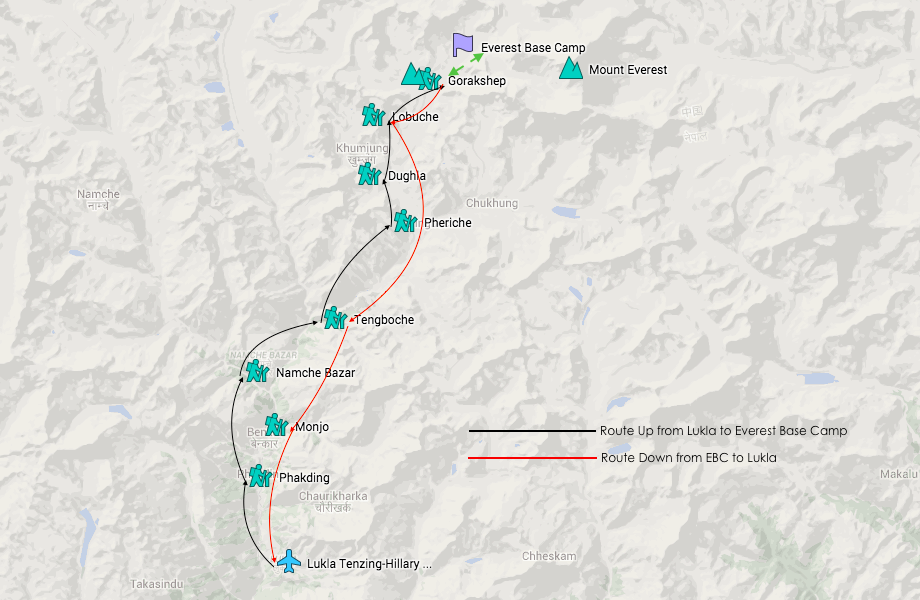 Click to open Google maps version
Click to open Google maps version
Everest Base Camp Trek in detail
Day 1 Kathmandu to Lukla and walk to Phakding (flying time 35 minutes and trekking time 2-3 hours)
Following check-in at Kathmandu airport at around 6am, if you are lucky you will be in the air by 9am and therefore making the spectacular landing into Lukla by 9.45am or so, ready to start trekking shortly afterwards.
The walk to Phakding is very straightforward and you probably won’t even break into a sweat. There are a couple of reasons why today is so easy; firstly you never know what time your flight is going to take off from Kathmandu and therefore what time you are going to arrive in Lukla. As a result, you cannot afford to be too ambitious with the amount of distance to be covered after arrival. Secondly, there is the acclimatisation factor to take into account; Lukla is 2840m above sea level and the key on this trek is to go slowly in order to acclimatise properly.
Accommodation in Phakding
Lodges/teahouses
There are plenty of lodges and teahouses in Phakding. On the couple of occasions I have been there, I have stayed at the Beer Garden Hotel (also known as the Shangri La). The new wing is far superior to the original building. All 14 rooms have private bathrooms and are clean and warm. The restaurants (all three of them!) serve excellent food and the service is very good.
Camping
The best spot without a doubt is at the Himalayan Chain Resort. The camping area is well spread out, there are good toilet and shower facilities and the location is very peaceful.
Day 2 Phakding to Namche Bazar (trekking time 5 hours)
It is a pleasant walk from Phakding to Monjo (1.5 to 2 hours) with no serious ups or downs along the trail. From Monjo you start to get mountain views as Mt. Thamserku comes clearly into view. Some trekkers have lunch here but personally I think it is too soon after leaving Phakding. It is better is to keep walking as far as Jorsale (Thumbug), which is a further 45 minutes from Monjo and located by the river. After lunch, you will criss-cross the river a few of times and also walk along the river bed before finally crossing to the left-hand side to begin the ascent up to Namche Bazaar. It is a steep upward climb for about 30 minutes to the view point (where hopefully you will get your first glimpse of Everest) before the hike turns into a more gradual climb for about another hour until you reach the entrance to the town.
Accommodation in Namche Bazaar
Lodges/teahouses
There are numerous places to stay in Namche. I stayed at the Camp De’ Base, which I thought was a good option. The old part of the lodge houses the very pleasant dining area and two new accommodation blocks, one with a common bathroom and the other with rooms with en suite bathrooms. Here the rooms are spacious and clean and for most of the day they catch the sunlight. Other good choices include Hotel Sherpa Land (which has a great outdoor sun trap), Zamling Guesthouse (which is perched on a hill close to the monastery and overlooks the town) and the Panorama Lodge (which has 24-hour electricity and hot showers).
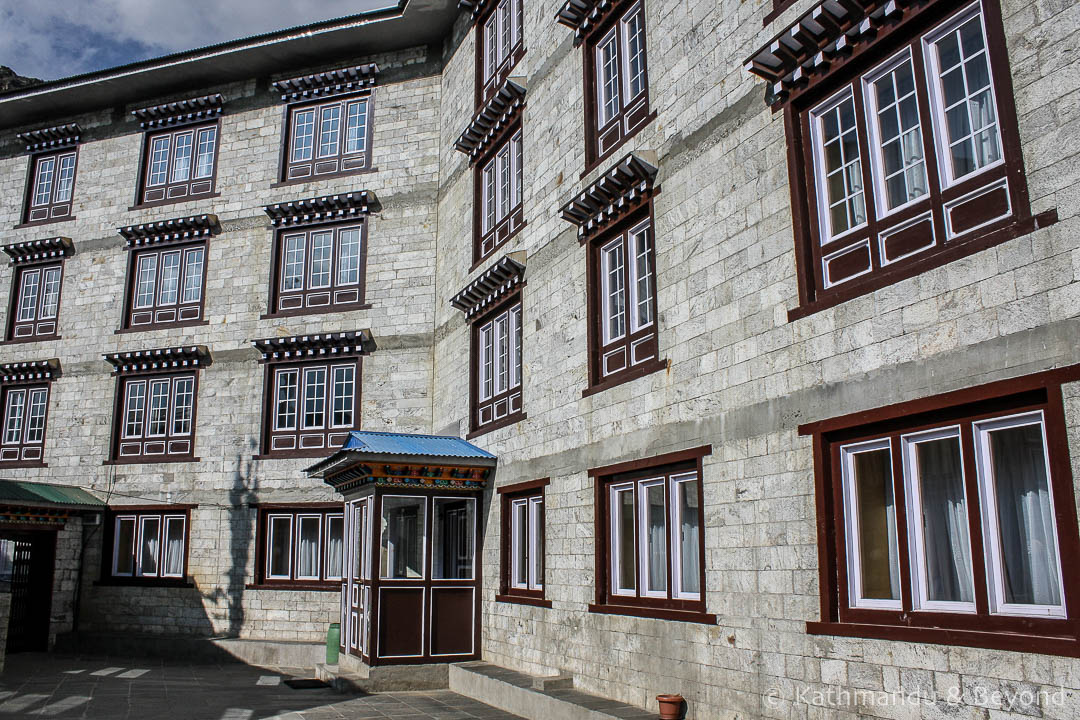 Hotel Sherpa Land, Namche Bazar
Hotel Sherpa Land, Namche Bazar
Camping
There is a very pleasant camping ground up above the Yeti Mountain Home, close to the town’s museum. You can also camp on the museum grounds. The views are excellent from up here and there are cooking and toilet facilities available.
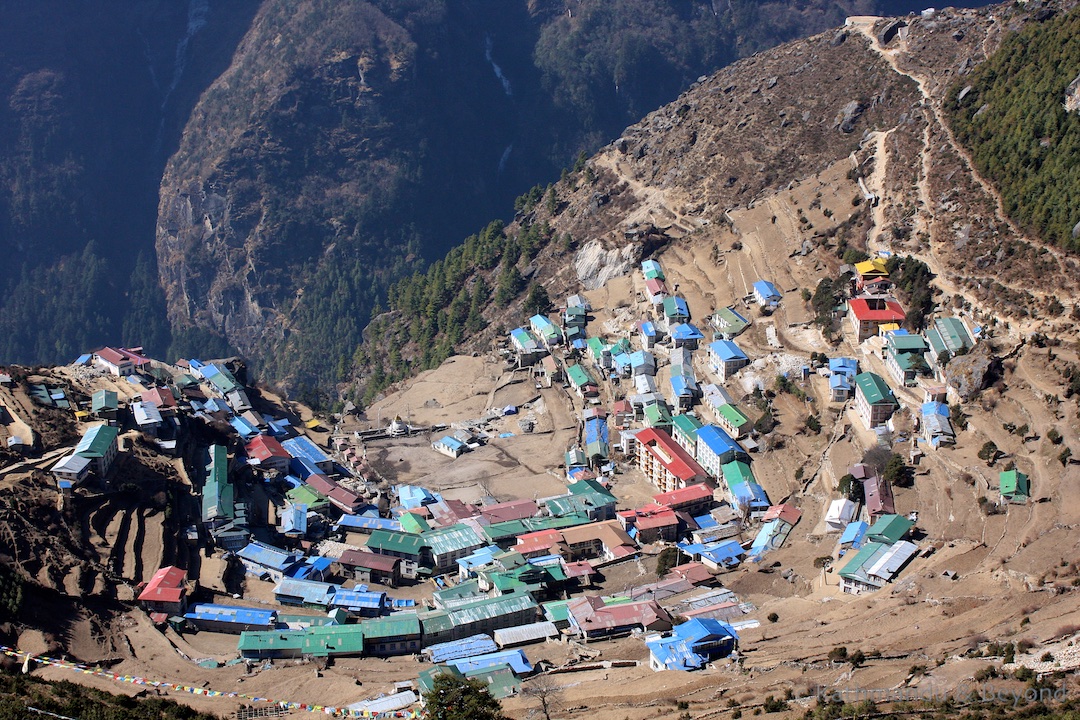 Namche Bazar
Namche Bazar
Day 3 Acclimatisation day at Namche Bazaar (4 to 5 hours optional trek)
Most acclimatisation days in the mountains are not in fact rest days but the opportunity to take a gentle trek in the surrounding area, catch some great views and adjust to the altitude. Of course you can simply relax – Namche has some great coffee shops and is an interesting place to explore – but should you feel like stretching your legs, a great option is to hike to the Hotel Everest View, continue down to Khumjung and then return to Namche Bazaar.
The trail is not difficult and once on the ridge above Namche (at the Syangboche Airstrip) the views are superb and will most definitely whet your appetite for the journey ahead. You get your first view of Everest but more striking is that of Ama Dablam which really stands out on its own. You can have a cup of tea at the Hotel Everest View and then walk down into Khumjung and then either head directly back to Namche or you can keep going and visit Kunde, the neighbouring village, which will add about an hour to the total time of the excursion.
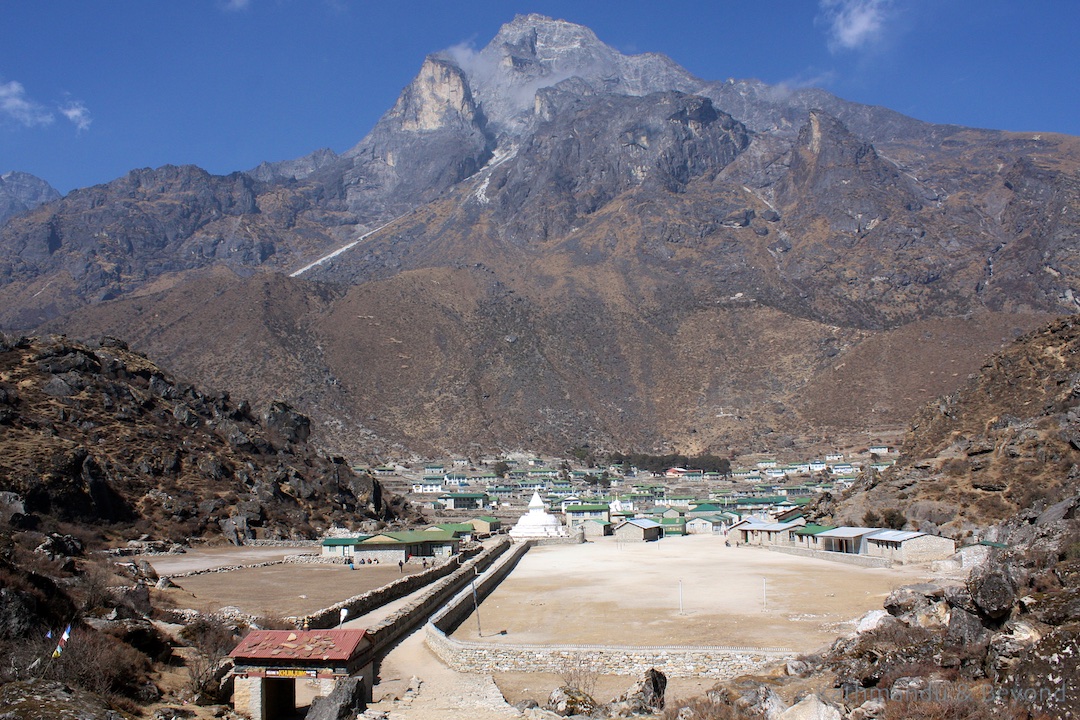 Khumjung
Khumjung
Day 4 Namche Bazar to Tengboche/Deboche (trekking time 5 to 6 hours)
Start the day with a stiff climb up and through Namche until the trail levels out and becomes flat for the next couple of hours. Just after Teshinga it is necessary to go down for about 15 minutes before crossing a bridge to Phunki Tenga. This is a good place to stop for lunch. From Phunki Tenga it’s a tiring 2 hour plus climb up to Tengboche (also spelt Thyangboche). For the best part you are walking through the forest but every now and then you are treated to excellent views of the mountains. Expect to arrive in Tengboche by early afternoon. Deboche (see below) is another 20 minutes further along the main trail.
Tengboche is a small but interesting place, where it is possible to spend time at the monastery and also enjoy the delicious offering at the German Bakery. The mountain views from Tengboche are excellent.
Accommodation in Tengboche
Lodges/teahouses
There are a handful of teahouses in Tengboche but none will inspire. The Gompa Lodge which, along with the German Bakery, is owned by the monastery is rather run down but acceptable. A better option to sleeping in Tengboche, in my opinion, is to continue walking for a further 20 minutes downhill to Deboche where you will find fewer trekkers, a slightly warmer environment (Deboche is 150m lower than Tengboche and less exposed to the elements) and superior accommodation. The Rivendell Lodge, which is located on the left-hand side as you enter the village, is an excellent choice plus there are a few other teahouses scattered throughout the village.
Camping
Located right outside the Visitors Centre, the camping spot in Tengboche is not particularly pleasant (or private) but there is plenty of space. Deboche has superior camping sites. The Rivendell Lodge has its own camping ground which is pleasant and, as you head further out of town, there are numerous sites that are much nicer than the one in Tengboche.
Day 5 Tengboche/Deboche to Pheriche (trekking time 5 to 6 hours)
It can be bitterly cold in Tengboche but it’s worth getting up early to witness the daily puja (prayer) ceremony at the monastery at 6am. You will miss this if you decide to sleep in Deboche but may catch the afternoon one at 3pm, depending on your arrival time.
Leaving Tengboche, the first 20 minutes is downhill to Deboche where you continue through the forest for a short period of time. Next, cross a bridge and begin the gradual ascent to Pangboche. This is a good place to stop for tea and don’t forget to take in the stunning views of Ama Dablam, one of the most striking mountains in the Everest region and considered by many mountaineers to be one of the hardest to climb.
Pheriche
Optional rest day in Pangboche
A rest day in Pangboche affords the opportunity to undertake a side-trip to Ama Dablam Base Camp. I haven’t personally done this but from what I understand from trekkers who have, it is a superb roundtrip walk of approximately five hours that provides incredible views of Ama Dablam. The trek is quite strenuous and only advisable if you are well acclimatised. It is also important to retain the acclimatisation day in Pheriche in your itinerary, i.e. not replace it with one in Pangboche.
After leaving Pangboche you head into open country with good views both to your left and in front of you (up towards the Chukhung valley). Orsho is a reasonable place to stop for lunch (alternatively consider an early lunch in Pangboche) and then it’s up and over the relatively easy Pheriche La (4270m), followed by a hike down to the river and eventually a short climb up to village of Pheriche itself.
Accommodation in Pheriche
Lodges/teahouses
There are two decent teahouses/lodges in Pheriche. The Himalayan Lodge has about fifteen rooms, some with attached bathrooms. The food is good as is the hot shower, and the atmosphere is cosy. The Yak Hotel is similar in standard to the Himalayan Lodge and also a good choice.
Camping
There are plenty of good camping spots in Pheriche. All of them are walled in to keep the yaks out and are close to lodges.
Buildings in Pheriche were damaged during the 2015 earthquake. I have checked with travel industry colleagues in Nepal and they advise me that both the above-mentioned teahouses are currently operational. An alternative base would be nearby Dingboche, a small village 30 minutes walk away that experienced very little earthquake damage. It is still possible to undertake the optional hikes listed below from Dingboche but the only issue is the village is 130m higher than Pheriche and this may increase the risk of altitude sickness.
Accommodation options include the Everest View Lodge and the Snowline Lodge. The most suitable camping is at the Ashi Bard Lodge but the campsites in Pheriche are better.
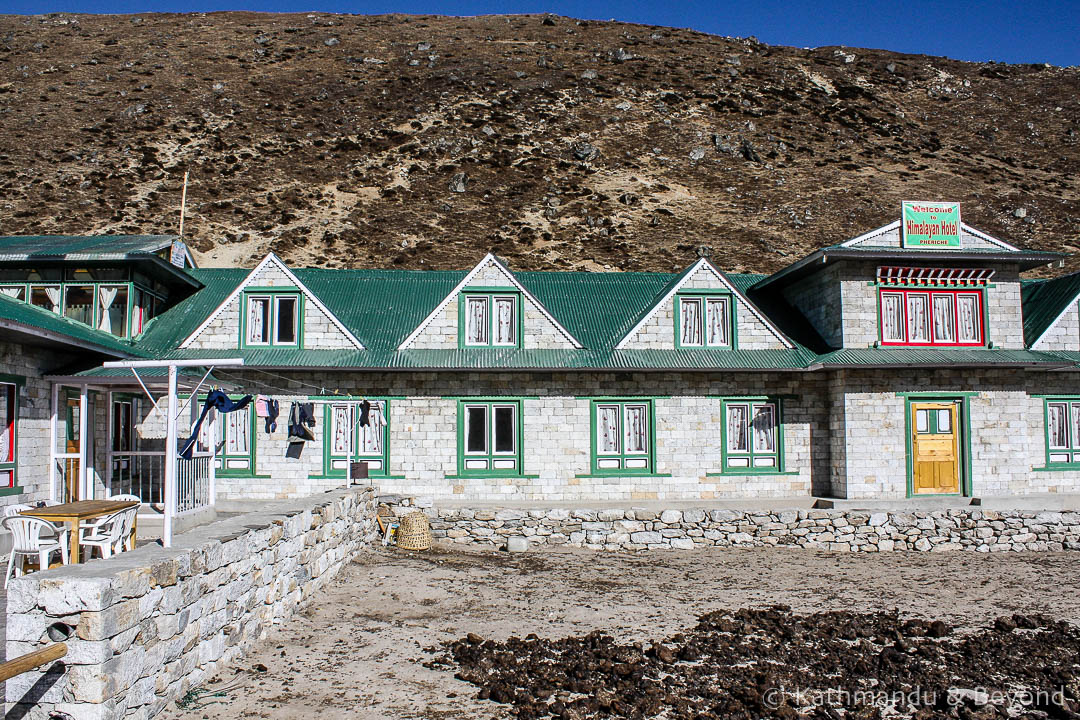 New Himalayan Lodge, Pheriche
New Himalayan Lodge, Pheriche
Day 6 Acclimatisation day at Pheriche (2 to 3 hours optional trek to Nagargum gompa or 5 hours trek to Chukhung or 7 hours trek to Chukhung Ri)
As you can see, there is plenty to keep you occupied in Pheriche. The walk to Nagargum gompa is a nice one but I would strongly recommend the trek up the valley to Chukhung. This is a fantastic trek and once there you are rewarded with stupendous views of Nuptse, Island Peak and Ama Dablam (from a completely different view point to the one seen in Pangboche) as well as the massive Lhotse Shar glacier that dominates the area. The trek is not too difficult and furthermore should aid acclimatisation for the days ahead as Pheriche is situated at 4270m above sea level and Chukhung at 4730m. For those with more energy it is possible to continue up Chukhung Ri (5560m), where you will get even better views of the surrounding area.
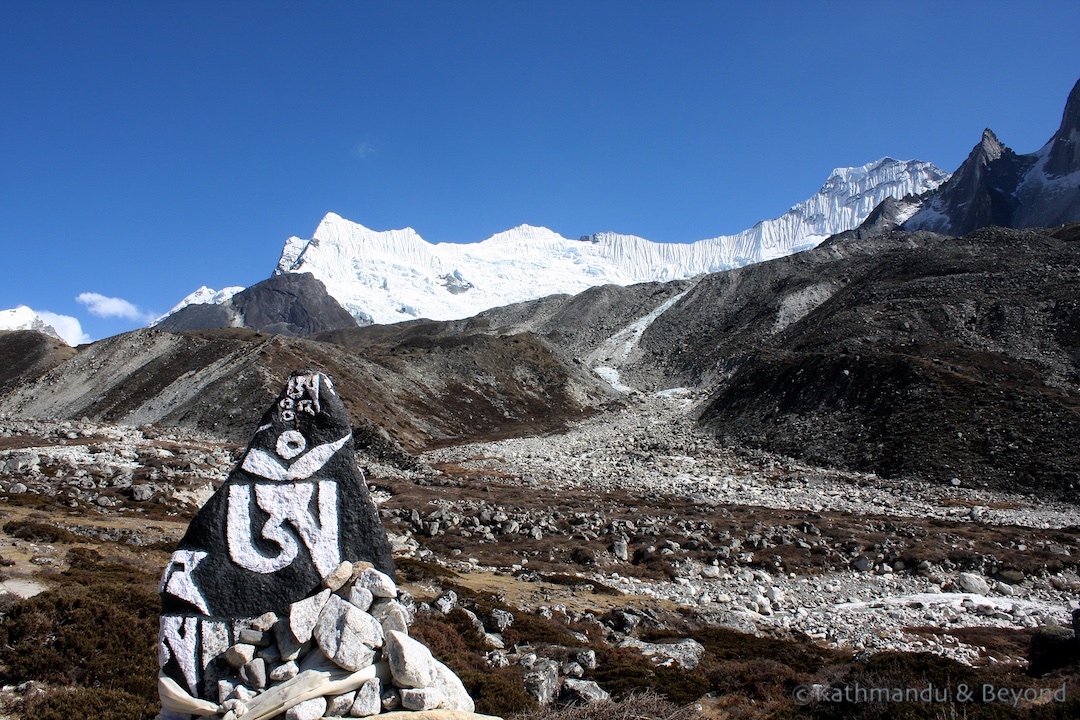 Chukhung Valley
Chukhung Valley
There are three or four places for lunch at Chukhung and the village also offers basic accommodation as this is the starting point for the popular ascent of Island Peak. If you do decide to walk up the valley, make sure you wear something to protect you from the wind, which is absolutely biting.
Day 7 Pheriche to Dughla (trekking time 2 hours)
Today and tomorrow are short days. It is very tempting to skip Dughla and continue onto Louche after leaving Pheriche but if you do this you will be breaking the golden rule of high altitude trekking (not ascending more than 500m from start to finish in one day when above an altitude of 3000m) by almost twofold.
From Pheriche you can either trek through the valley and climb up to Dughla when you reach the end of it, or you can climb up onto the ridge behind Pheriche and follow this as far as Dughla. Either way, the views are superb and as long as you are not battling the elements (as I had to) you will really enjoy this section of the trek. You will be rewarded with top to toe views of both Cholatse and Taboche (Tawachee) and yet another perspective of Ama Dablam. As you make the final ascent to Dughla you are stepping onto the Khumbu Glacier for the first time.
Accommodation in Dughla
Lodges/teahouses
There is not much to Dughla – a couple of teahouses and that’s your lot. Of the two accommodation options, the Yak Lodge is the nicest one as it has a sunny courtyard. The other teahouse is called the Kala Pathar Lodge. Even though an early start is not necessary, it’s a good idea to get to Dughla as soon as you can as beds are limited. Alternatively, send a member of your trekking crew on ahead to secure space for you.
Camping
It is possible to pitch your tent close to the Yak Lodge.
Day 8 Dughla to Lobuche (trekking time 3 hours)
After leaving Dughla you immediately head up the gravelly terrain of the Khumbu Glacier to the Thok La. At 4830m this is the first real challenge (in terms of passes) on this trek and it takes at least an hour of slow trudging to reach the top. Once there, you will notice a number of memorials known collectively as the Chukpilhara – they are dedicated to sherpas and climbers who have perished in this region.
The climb down the other side is gentle and you will reach Lobuche within an hour. For those with energy, it is possible to take a late afternoon excursion up onto the ridge to the east of the village for fine views of the Khumbu Glacier.
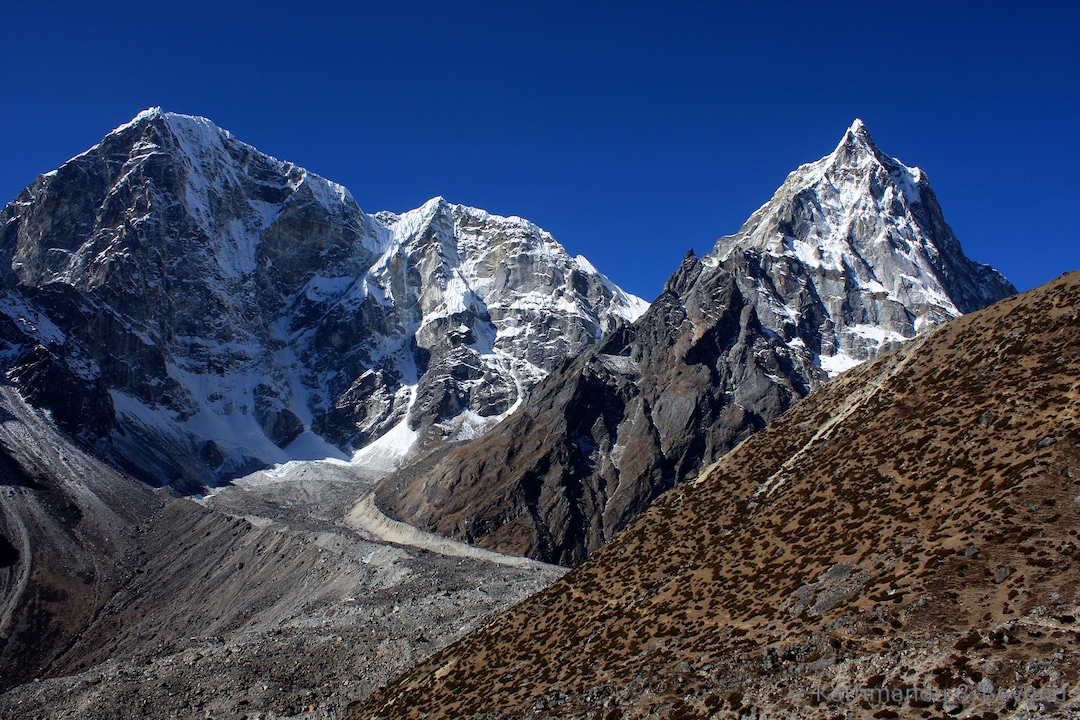 En route between Dingboche and Lobuche
En route between Dingboche and Lobuche
Accommodation in Lobuche
Lodges/teahouses
There are about four or five teahouses in Lobuche. All are similar except for the Eco Lodge, which is part of the Himalayan chain of properties. The Eco Lodge is more expensive than the other teahouses but worth it. The place is kept clean, the food is excellent and although none of the rooms have attached bathroom, the common one is well-maintained and has a good hot shower.
Camping
Several campsites are situated north of the village. They all offer a pretty remote setting.
Note, I suffered with AMS at Lobuche and eventually had to abandon my attempt to reach Everest Base Camp. You can read more about AMS and my experience of it here. As a result the following description (Lobuche to Gorak Shep and onto Everest Base Camp/Kala Patthar and then back to Lobuche) is not first-hand. My account is based on information I received from my trekking partner at the time, Gautam, and my Sherpa/guide named Naryn. Both have completed the trek many times. I also gleaned information from other trekkers while I was the in the region.
Day 9 Lobuche to Gorak Shep (trekking time 3 hours)
The morning starts with a slow trudge up the Khumbu Valley. Eventually, you will reach the top of the Lobuche La (5110m), from where it is a 45-minute walk across the Changri Shar Glacier to Gorak Shep.
In the afternoon it is possible to either visit either Base Camp or Kala Patthar but not both. Most trekkers visit Base Camp on the afternoon of arrival and make the ascent of Kala Patthar very early the following morning. There is a school of thought that says it is not worth getting up very early in the bitter cold for the ascent of Kala Patthar as the sun rises behind Everest and therefore it is better to make the climb in the afternoon and then head to Base Camp the following morning. This is a reasoned argument but keep in mind that you do run the risk of cloud cover as the day progresses.
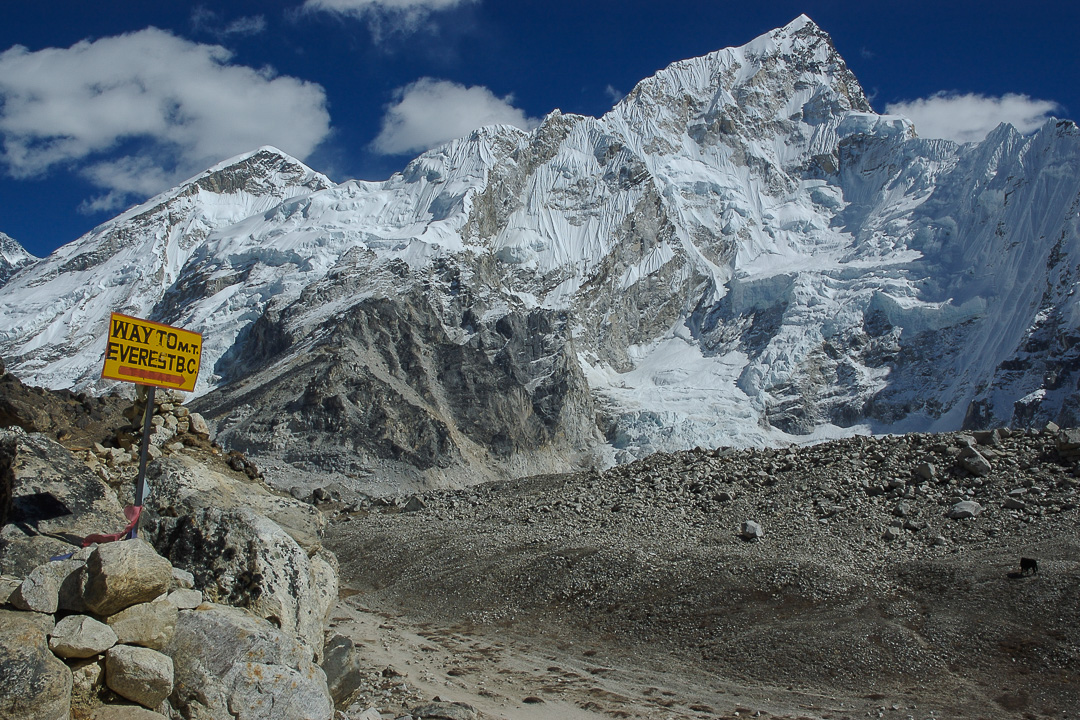 En route to Everest Base Camp | Image © Andrew Eland
En route to Everest Base Camp | Image © Andrew Eland
The return trip to Kala Patthar from Gorak Shep is in the region of 4 to 5 hours and to get to Base Camp the round trip takes approximately 6 hours, according to your pace.
In order to avoid the discomfort of sleeping at Gorak Shep (Lobuche isn’t that much better), some trekkers spend two nights in Lobuche and visit either Base Camp or Kala Patthar from there but this is a very long day (minimum 8 hours) and a very early start will be required.
Accommodation in Gorak Shep
Lodges/teahouses
There are a handful of lodges in Gorak Shep. Once again, it is advisable to arrive as early as possible as bed space is at a premium.
Camping
Camping is available just below the village close to the lake.
Note, apart from the odd ascent and some potential knee-jarring descents, coming back down the trail from Gorak Shep is a breeze. Fitness levels are at a peak and there shouldn’t be any issues with altitude. As a result, many trekkers feel fantastic and keep going past their intended overnight halt. I have suggested places to overnight in this final section of the description but, limitations with any trekking crew aside, there is nothing to stop you from continuing if energy levels permit.
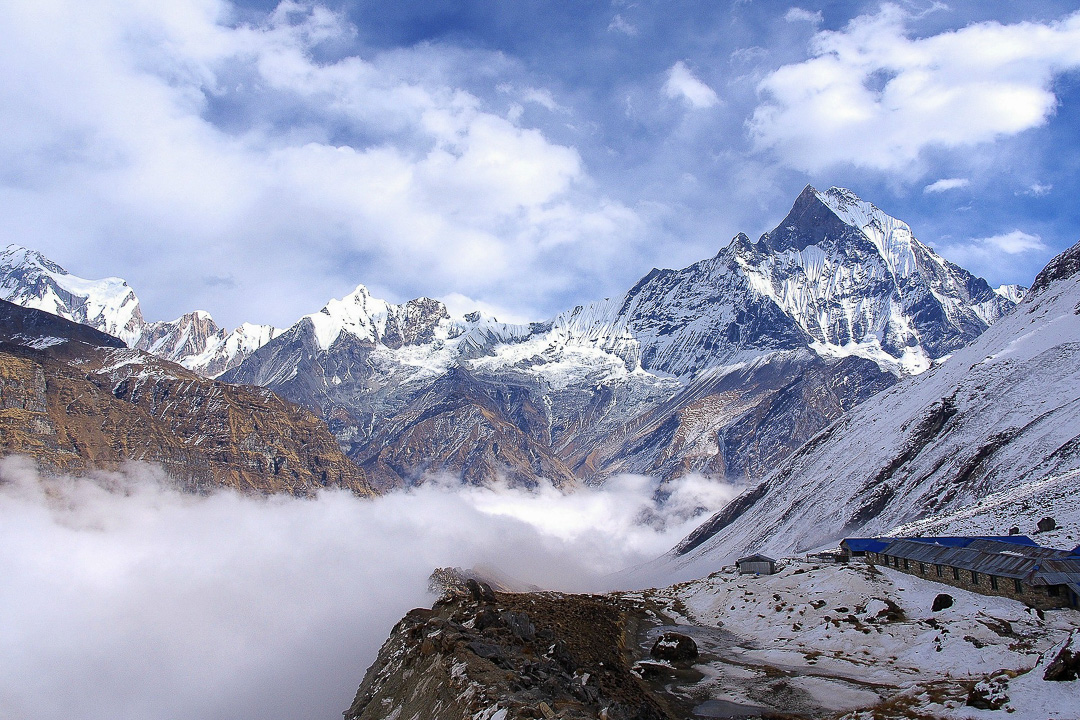 Gorak Shep
Gorak Shep
Day 10 Gorak Shep to Lobuche (trekking time 2 hours)
Assuming you visit Everest Base Camp on the previous afternoon, an excursion to Kala Patthar is the first thing on the agenda this morning. Getting back to Lobuche, should present no serious challenges. If you can descend even lower, you will probably have a better night’s sleep.
Day 11 Lobuche to Deboche/Tengboche (trekking time 6 hours)
This will be a long day but you will cover a lot of ground and by the end of it you will have descended over a 1000m which will should result in the best night’s sleep you will have had in a while. The trail is flat for the first 40 minutes or so until you reach the head of the Thok La, from where it is a comfortable descent down past Dughla and along the valley floor (stunning views) as far as Pheriche. The Pheriche La will not present any problems and it is then a gradual descent through Orsho as far as Pangboche, which is a good place to stop for lunch.
After leaving Pangboche you head down to the river and cross the suspension bridge and then climb slightly up for about 10 minutes or so then walk on the flat all the way to Deboche. If you decide to sleep in Tengboche, it is a stiff 30 to 40 minute climb (up steps) to the ridge and village itself.
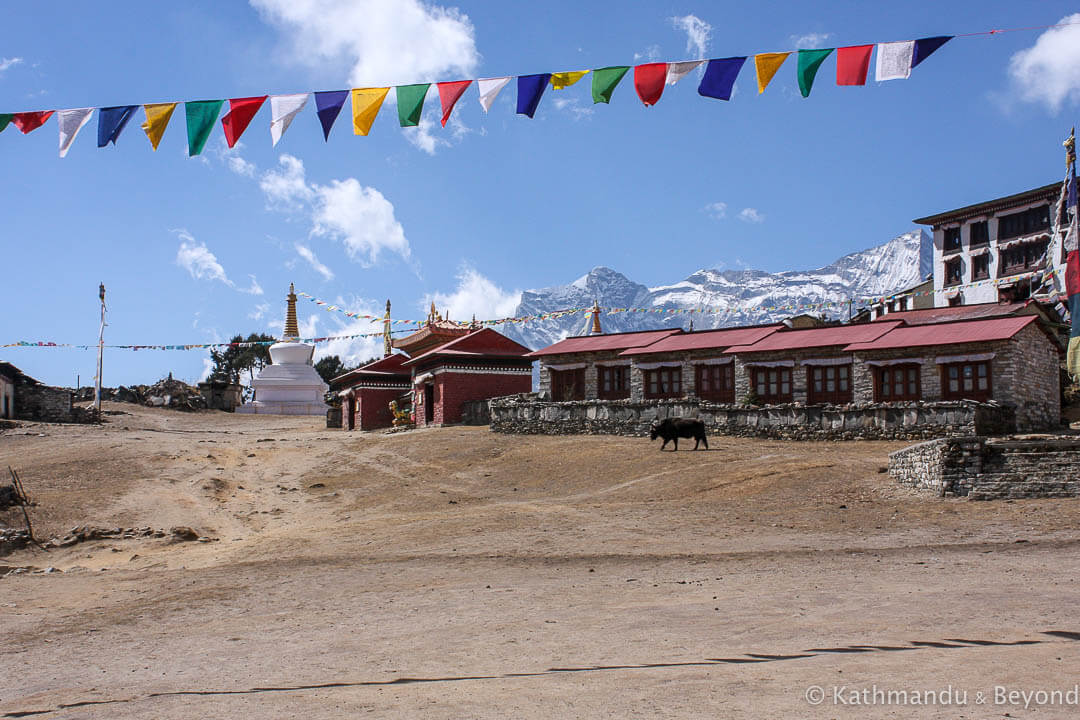 Tengboche
Tengboche
Day 12 Deboche/Tengboche to Monjo (trekking time 7 hours)
Another long day which starts with either the stiff climb up from Deboche to Tengboche or a very nasty descent (painful on the knees) from Tengboche to Phunki Tenga, a small village situated on the Dudh Koshi River. The walk takes at least 45 minutes and you really need a rest by the time you reach the bottom. You then have to ascend the ridge to Sanasa and from there it is a straightforward 1.5 hour traverse along the ridge to Namche Bazaar, where you can have a good lunch before continuing. After walking through Namche you start to head down to the river on a very dusty and busy trail that leads you to the even busier suspension bridge that crosses to the opposite side. Apart from a few steps up to the Sagarmatha National Park Entrance building, this is a pleasant stretch of the trail that leads you along the river bank and finally to Monjo.
Accommodation in Monjo
Lodges/teahouses
Everest Summit Lodge aside, in my opinion the best medium grade option is the Mount Kailash Lodge. It is quite a rambling building; make a beeline for the rooms in the wooden block where all bar one of them have a private bathroom. The Summit Home is also worth considering but it’s not as nice as the Mount Kailash Lodge.
Camping
Camping is not great in Monjo. The best site is right in the middle of the village and attached to the Himalayan Lodge.
Day 13 Monjo to Lukla (trekking time 5 hours)
This is a pretty boring day. The trail is busy and passes through a lot of villages. You begin by going down to Phakding (where you stayed on the way up) and then, after more down, you eventually start climbing up the final rather steep section before reaching Lukla. All being well, you should arrive in Lukla by mid-afternoon.
Accommodation in Lukla
Lodges/teahouses
Lukla is well-developed on the lodge and teahouse scene. At the upper end of the market I very much liked the Yeti Mountain Home Lukla. Situated at the opposite side of the town to the airport, this spacious lodge has very nice rooms (all with attached bathrooms), a really welcoming bar and restaurant area as well as plenty of outdoor space for relaxing and soaking up the sun. Because of its location, it also has the advantage of being very quiet and peaceful. Yeti Mountain Homes is also a chain with properties in Phakding, Namche, Thame and Kongde as well as Lukla.
An excellent lower grade lodge is the Lukla Mountain Hotel, which is situated next to the airport runway. All the rooms are clean, have attached bathrooms and are (for the best part) bright and airy. The hotel has one of the best campsites in town (see below) and there is a further incentive to sleep at this property as the owner is also the airport manager for Yeti Airlines and therefore a very useful contact to have. In addition, the service and food is good at this lodge.
Camping
The best I saw was located at the Lukla Mountain Hotel. It has its own cooking area and campers are allowed to use the showers and toilets inside the lodge.
Day 14 Lukla to Kathmandu (flying time 45 minutes)
There is always a buzz in the morning, with everyone (locals and trekkers alike) predicting whether there are going to be flights or not. The advantages of staying at the Lukla Mountain Hotel are clear and it also means minimal hanging around at the airport. You need to be up and your bags packed by 06.30am and your return flight (if the weather is good) will take off any time between 07.30am and 10.00am, sometimes even later.
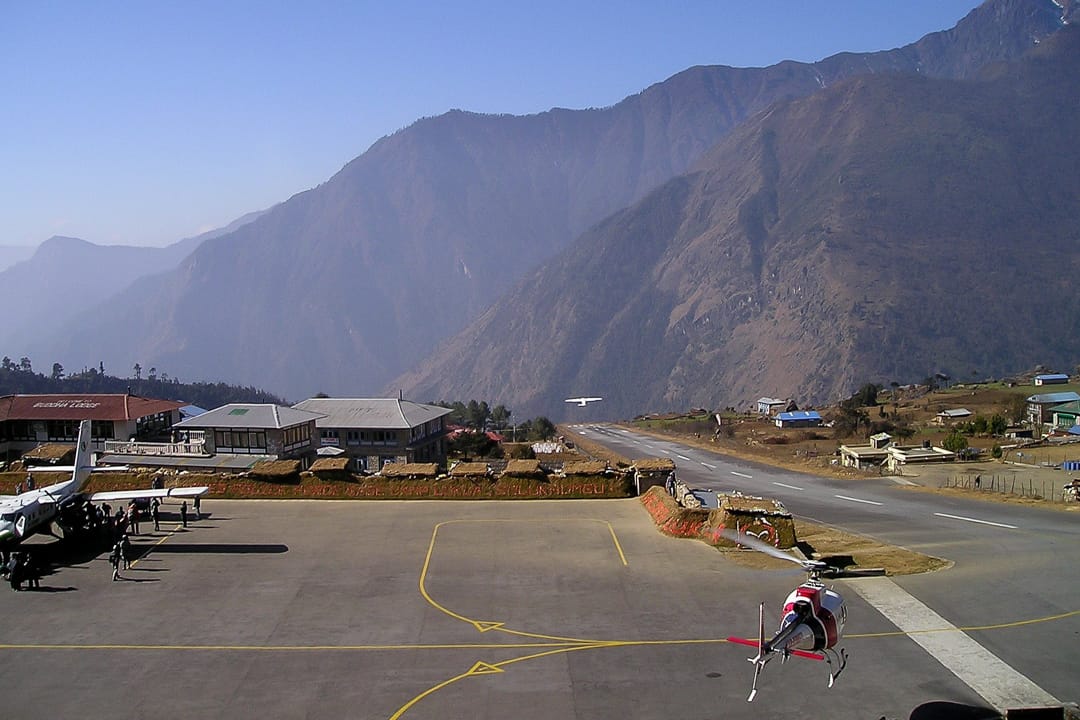 Lukla airport
Lukla airport
Flights in and out of Lukla are weather dependent and are often delayed or cancelled. As a result, if you are on fixed schedule and heading back to Kathmandu for an onward international flight, I would strongly recommend building at least one contingency day back in Kathmandu (two would be better) into your itinerary. Trust me, a day or two of chilling in Kathmandu because your Lukla to Kathmandu flight miraculously took off as per schedule is preferable to trying to reschedule an international flight home because the one you were booked on took off two days previous!
Alternative routes on the Everest Base Camp trek
It is possible to link the Everest Base Camp trek with the Gokyo Lake trek by traversing the Cho La Pass. This is a very tough trek and not for the inexperienced – prepare for glacier walking, snow and ice, scree, boulder hopping, exposed trails, very basic facilities and a reasonable risk of avalanches. Both trekkers and crew (if you have one) need to be fully equipped to battle both the elements and the altitude. Several guides and sherpas that I met whilst living in Nepal said that in their opinion, the pass was too dangerous to cross and should be closed to trekkers. As I’ve never crossed the pass myself, it is hard for me to give a first-hand opinion but I met a number of trekkers who attempted it and their reviews were mixed. Some said it was extremely difficult, while others said it was OK and manageable. Others abandoned their attempts and headed back the way they had come.
A much safer and more feasible way to link the two treks would be to walk back down from Gokyo Lake as far as Phortse Tenga and then cross the river to Phortse and head up towards Everest Base Camp from there. Although this involves some back-tracking, it is a less dangerous option than crossing the Cho La Pass. If this was your plan, my suggestion would be to head up to Gokyo Lake first and then continue with the Everest Base Camp trek. My rationale is based on the fact that the maximum elevation on the Gokyo Lake trek is lower than on the Base Camp trek so you should acclimatise better. What’s more, for many the highlight will be reaching Everest Base Camp and it’s always best to leave the highlight until last!
A brief summary of the route would be something like this:
Note; I have omitted the night in Dughla on the assumption that you should be well acclimatised if you have previously trekked up to Gokyo Lake.
Day 1 Kathmandu to Lukla by air and onto Phakding (2/3 hours walking)
Day 2 Phakding to Namche Bazaar (5 hours walking)
Day 3 Namche Bazaar rest day
Day 4 Namche Bazaar to Phortse Thanga (3 hours walking)
Day 5 Phortse Thanga to Machhermo (4 hours walking)
Day 6 Machhermo to Gokyo (4 hours walking)
Day 7 Gokyo rest day
Day 8 Gokyo to Phortse Tenga (6 hours walking)
Day 9 Phortse Tenga to Pangboche (5 hours walking)
Day 10 Pangboche to Pheriche (5/6 hours walking)
Day 11 Pheriche rest day
Day 12 Pheriche to Lobuche (5 hours walking)
Day 13 Lobuche to Gorak Shep (3 hours walking)
Day 14 Gorak Shep to Lobuche (2 hours walking)
Day 15 Lobuche to Deboche (6 hours walking)
Day 16 Deboche to Monjo (7 hours walking)
Day 17 Monjo to Lukla (5 hours walking)
Day 18 Lukla to Kathmandu by flight
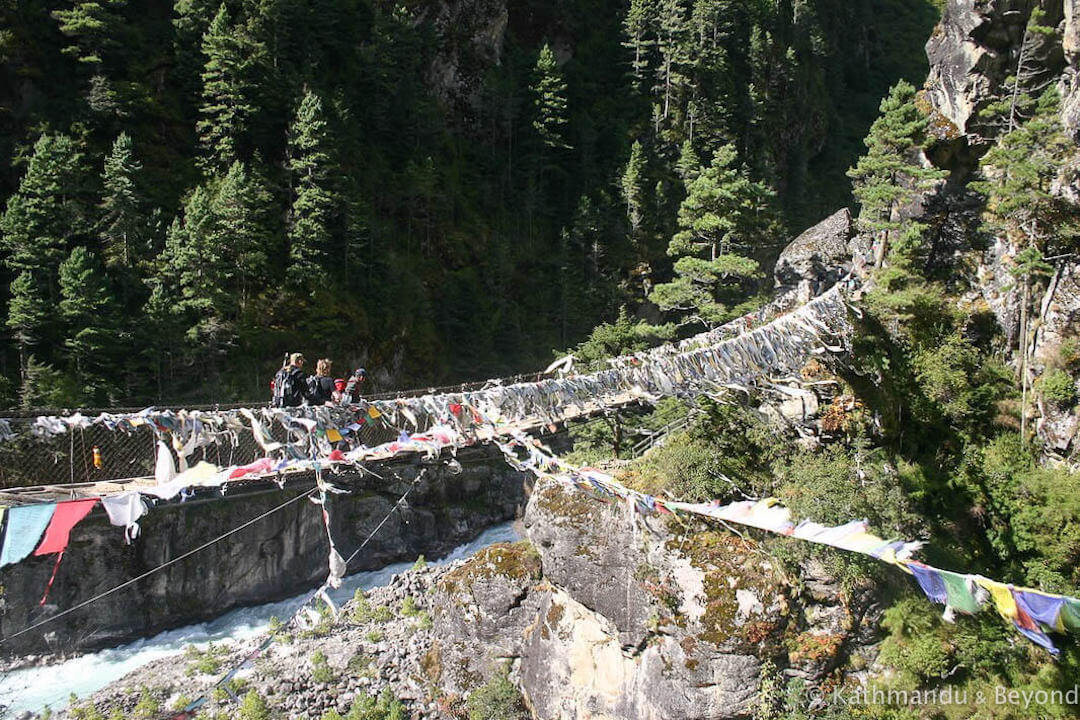 Suspension bridge en route between Monjo and Tashinga
Suspension bridge en route between Monjo and Tashinga
Opinion on the Everest Base Camp trek
Towering mountains, photogenic local people, dodgy take-offs and landings, yaks, monks, brilliant side trips and huge glaciers – what’s not to love about this trek … it’s got a little bit of everything. On the downside, it can get impossibly crowded on the trail in high season and many trekkers (myself included) who have hiked in both the Annapurna and the Everest region invariably prefer the former for that exact reason.
The trek to Base Camp is also a lot tougher than you imagine. Because so many people undertake the trek, there is a misconception that it is easier than it actually is. It’s not, but as long as you don’t underestimate the altitude, the cold, the terrain underfoot and you are prepared, you will have the trek of your lifetime.
Disclaimer. This trek was undertaken a few years back and hence information about the splendour or otherwise of teahouses and camping sites may be slightly out of date. The Everest region suffered some damage during the devastating earthquake of April 2015 but the trekking routes were largely unaffected. I have checked with travel industry colleagues in Nepal and incorporated their updates but if you come across new information please feel free to update me. All such contributions will be duly acknowledged. Mark

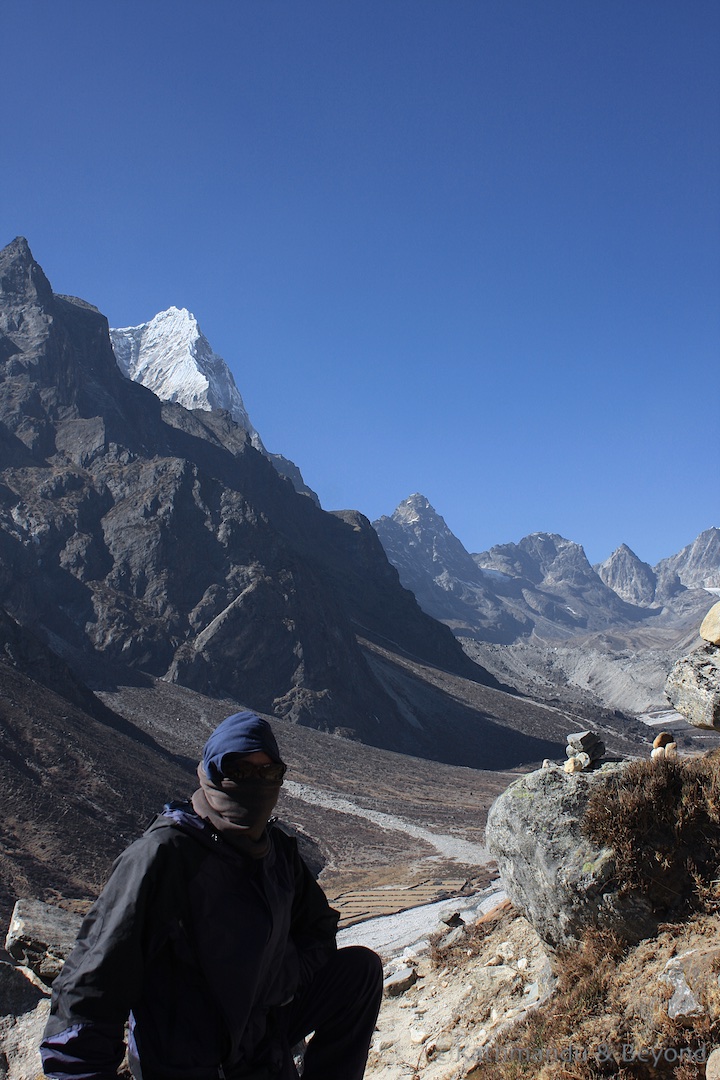
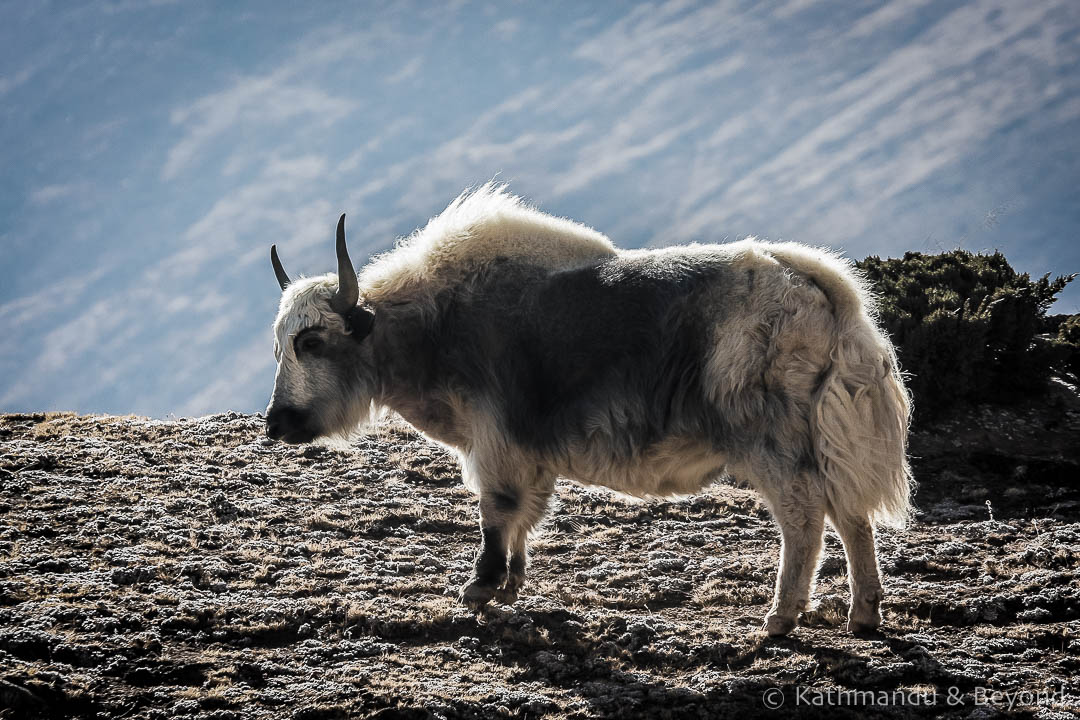
Trackbacks/Pingbacks